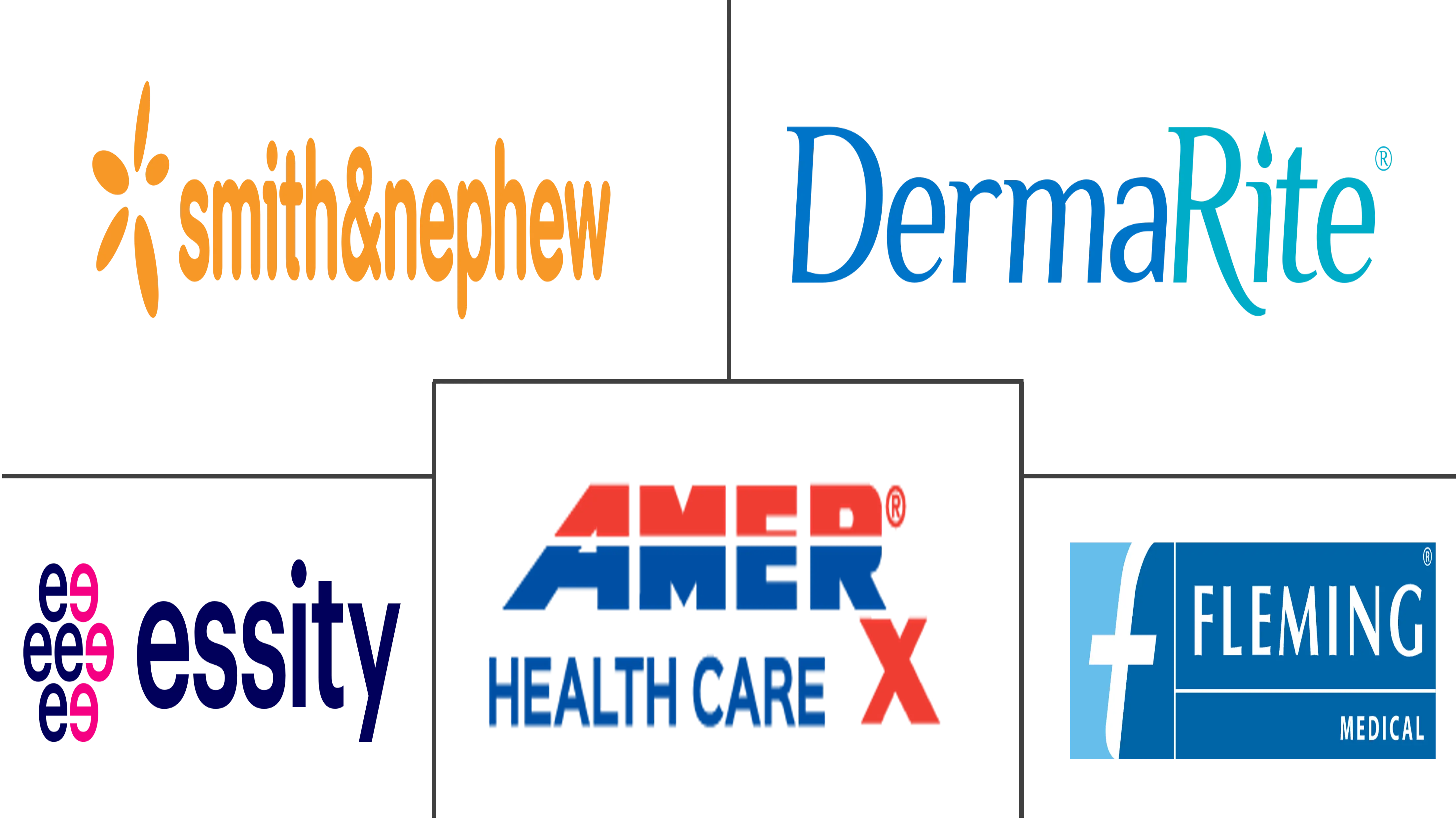Moist Wound Dressings Market Size and Share
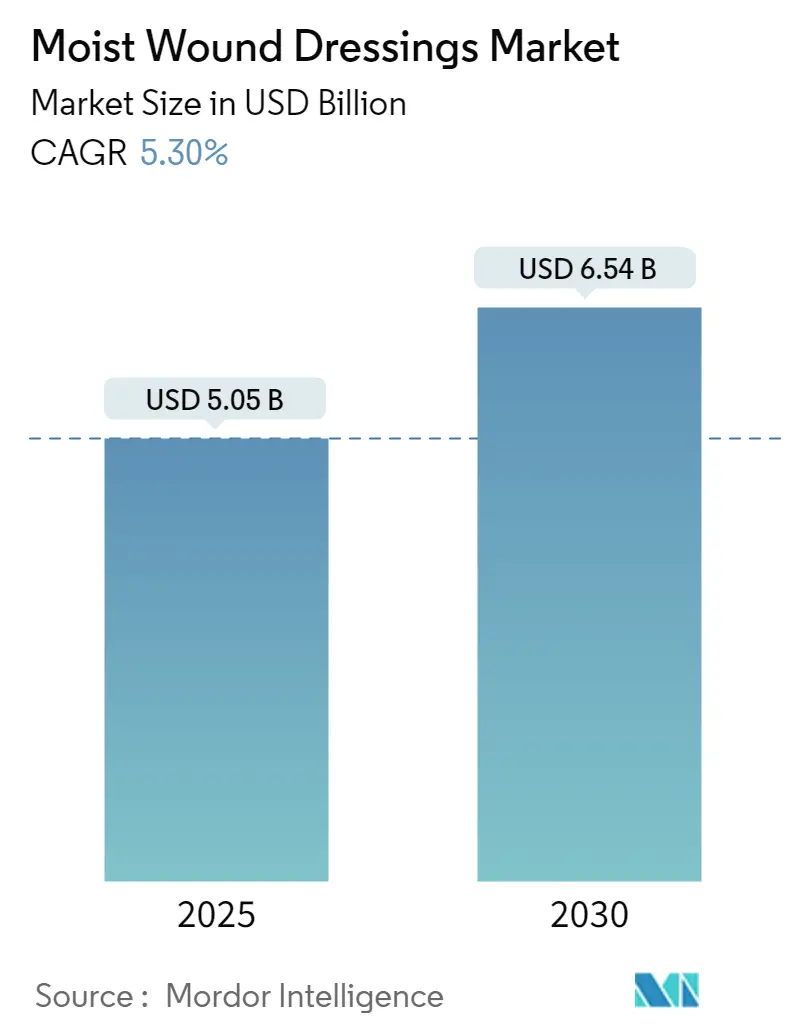
Moist Wound Dressings Market Analysis by Mordor Intelligence
The moist wound dressings market generated USD 5.05 billion in 2025 and, on its present growth path of 5.30% CAGR, is forecast to reach USD 6.54 billion by 2030. Continuous migration from dry gauze to moisture‐retentive solutions underpins this advance, as clinical data confirm that controlled hydration speeds epithelialization and limits scarring. Hospitals and payers increasingly recognize that optimized moisture balance reduces lengthy inpatient stays and costly complications, a realization amplified by the global rise in chronic wounds linked to aging and diabetes. Competitive intensity is heightening as smart sensor layers, pH‐responsive polymers, and antimicrobial additives alter what healthcare providers expect from a dressing, transforming a once commodity-like product into a data-enabled therapeutic. Regulatory momentum further supports innovation: the U.S. Food and Drug Administration (FDA) designated enzymatic infection-sensing dressings as Class II devices in June 2025, clarifying the pathway for next-generation monitoring technologies. In parallel, reimbursement reforms that reward demonstrable healing outcomes are nudging purchasing decisions toward evidence-backed brands, encouraging consolidation around manufacturers able to pair materials science with measurable clinical benefit.
Key Report Takeaways
- By product type: Foam dressings led with 23.87% of moist wound dressings market share in 2024; hydrocolloid dressings are projected to grow at 6.02% CAGR through 2030.
- By application: Surgical and traumatic wounds accounted for 36.45% of the moist wound dressings market size in 2024, while diabetic foot ulcers are advancing at 6.35% CAGR to 2030.
- By end user: Hospitals held 56.91% revenue share in 2024, yet homecare settings record the highest forecast CAGR at 6.57% to 2030.
- By geography: North America captured 43.71% of the moist wound dressings market in 2024; Asia-Pacific is poised to expand at 6.89% CAGR between 2025-2030.
Global Moist Wound Dressings Market Trends and Insights
Drivers Impact Analysis
| Driver | (~) % Impact on CAGR Forecast | Geographic Relevance | Impact Timeline |
|---|---|---|---|
| Increasing incidence of chronic & acute wounds | +1.1% | Global, concentrated in North America & Europe | Long term (≥ 4 years) |
| Growing geriatric population & diabetes prevalence | +1.4% | Global, highest impact in Asia-Pacific | Long term (≥ 4 years) |
| Accelerating adoption of home-based chronic-wound management | +0.6% | North America, Europe, urban Asia-Pacific | Medium term (2-4 years) |
| Favorable reimbursement reforms in OECD outpatient settings | +0.7% | North America & Europe | Medium term (2-4 years) |
| Rise of smart-sensor dressings enabling tele-monitoring | +0.8% | North America, Europe, urban Asia-Pacific | Medium term (2-4 years) |
| Climate-linked uptick in burn & trauma cases | +0.3% | Global, seasonal variations by region | Short term (≤ 2 years) |
| Source: Mordor Intelligence | |||
Increasing Incidence of Chronic & Acute Wounds
Roughly 6.7 million Americans live with a chronic wound, a population expected to climb as peripheral arterial disease, obesity, and diabetes intersect with older age. The American Heart Association noted in 2024 that diabetic foot ulcer patients face a >25% lifetime risk and a 70% five-year post-amputation mortality rate [1]John Doe, “Diabetic Foot Ulcer: Lifetime Risks and Outcomes,” American Heart Association, ahajournals.org. Such statistics are steering providers toward early use of advanced moist dressings that shorten healing cycles and curb readmissions. Hospital cost modeling in the European Union shows diabetic foot ulcer admissions averaging EUR 4,888 (USD 5,308) per patient, with 88% of costs tied to prolonged stays. Payers therefore view moisture-retentive protocols not as optional extras but as cost-avoidance tools.
Growing Geriatric Population & Diabetes Prevalence
Asia-Pacific adds more than 45 million individuals aged ≥65 each year, and many also live with diabetes, peripheral neuropathy, or vascular insufficiency. Scientific Reports found that 44.4% of diabetes patients developed neuropathy, 21.7% underwent amputations, and 96.9% reported poor quality of life [2]Jane Smith, “Smart Bandages with pH-Responsive Hydrogels,” Nature, nature.com . Hyperglycemia triggers oxidative stress and macrophage imbalance, slowing natural closure phases. Advanced moist dressings address such biological hurdles by preserving endogenous growth factors and optimizing exudate management, making them first-line therapy in many specialty clinics.
Favorable Reimbursement Reforms in OECD Outpatient Settings
The Centers for Medicare & Medicaid Services (CMS) introduced caregiver training codes G0541 and G0542 in its 2025 Outpatient Prospective Payment System rule, letting clinicians bill for remote wound-care instruction. CMS also expanded coverage for cellular tissue-based products from four to eight applications across 16 weeks when specific criteria are met [3]Centers for Medicare & Medicaid Services, “CY 2025 OPPS Final Rule,” CMS, cms.gov. Private payers followed suit; Organogenesis now reports access under 1,500 commercial plans covering 90% of U.S. lives. Such reimbursement breadth encourages clinicians to adopt premium dressings with proven efficacy, reinforcing value-based purchasing.
Rise of Smart-Sensor Dressings Enabling Tele-Monitoring
Caltech’s iCares smart bandage continuously samples wound fluid and flags infection-related biomarkers up to 24 hours before visible symptoms, reducing unnecessary clinic visits. The FDA cleared Microlyte Ag/Lidocaine, the first antimicrobial dressing containing lidocaine for pain relief, highlighting regulatory acceptance of multifunctional platforms. Academic prototypes combining pH-responsive hydrogels with Bluetooth patches achieved 30% faster closure than gauze in a 2024 Nature study. As hospital systems push digital care models, manufacturers that merge moisture control with real-time analytics stand to differentiate in the moist wound dressings market.
Restraints Impact Analysis
| Restraint | (~) % Impact on CAGR Forecast | Geographic Relevance | Impact Timeline |
|---|---|---|---|
| High product & procedure cost | -0.7% | Global, particularly emerging markets | Medium term (2-4 years) |
| Limited reimbursement in emerging economies | -0.5% | Asia-Pacific, Latin America, Africa | Long term (≥ 4 years) |
| Infection risk from improper moist-dressing usage | -0.3% | Global, higher in resource-limited settings | Medium term (2-4 years) |
| Stricter eco-toxicity rules on silver dressings | -0.2% | Europe, North America, expanding globally | Long term (≥ 4 years) |
| Source: Mordor Intelligence | |||
High Product & Procedure Cost
In Spain, chronic wound care consumed EUR 34,991,854 (USD 38,057,000) in primary care over three years, with materials alone costing EUR 8,455,787 (USD 9,203,000) and clinician time making up the remainder. Multiple dressing changes per week compound expenses for payers and patients. Similar patterns appear in India, where diabetic foot ulcer treatment is often paid out of pocket, shrinking access to advanced dressings. Tiered product ranges and smaller pack sizes aim to bridge price gaps but risk commoditizing innovations.
Limited Reimbursement in Emerging Economies
Advanced wound care adoption in many low- and middle-income countries is hampered by limited national insurance coverage, prioritization of communicable diseases, and a scarcity of wound-care specialists. Although Asia-Pacific contains large diabetic populations, only a fraction of public hospitals routinely stock hydrocolloids or hydrogels. Over the forecast period, economic growth and donor-supported universal health schemes could unlock latent demand, yet reimbursement gaps remain a near-term drag on the moist wound dressings market.
Segment Analysis
By Product: Foam Leadership Meets Hydrocolloid Innovation
Foam dressings accounted for 23.87% of moist wound dressings market share in 2024, reflecting their broad applicability across postoperative, pressure, and trauma wounds. Their polyurethane matrix balances high absorption with thermal insulation, reducing dressing changes and protecting peri-wound skin. Technological upgrades—such as Smith+Nephew’s ALLEVYN Ag+ SURGICAL, which combines silver ions with a flexible trilaminate—strengthen clinical appeal. Hydrocolloid formats, although smaller in today’s revenue terms, display the fastest 6.02% CAGR. High gel-forming capacity and seven-day wear time make hydrocolloids an increasingly preferred preventive measure for pressure injury in immobile patients, particularly in homecare. The FDA’s streamlined 510(k) exemption for hydrocolloid formulations lowers entry barriers and sparks niche players to innovate on odor control, transparency, and biodegradability.
Over 2025-2030, alginate and hydrogel categories are expected to carve distinct roles rather than challenge foam outright. Alginate’s calcium-sodium ion exchange underpins hemostatic performance in profusely exuding wounds, ensuring it remains indispensable in emergency departments. Hydrogel sheets, prized for cooling analgesic effects, dominate oncology-related radiation burns and necrotic tissue debridement. Film, contact-layer, and composite dressings retain niche status but gain renewed attention as sensor backings for smart platforms. Together these dynamics reinforce a multi-product portfolio imperative for firms seeking durable positions in the moist wound dressings market.
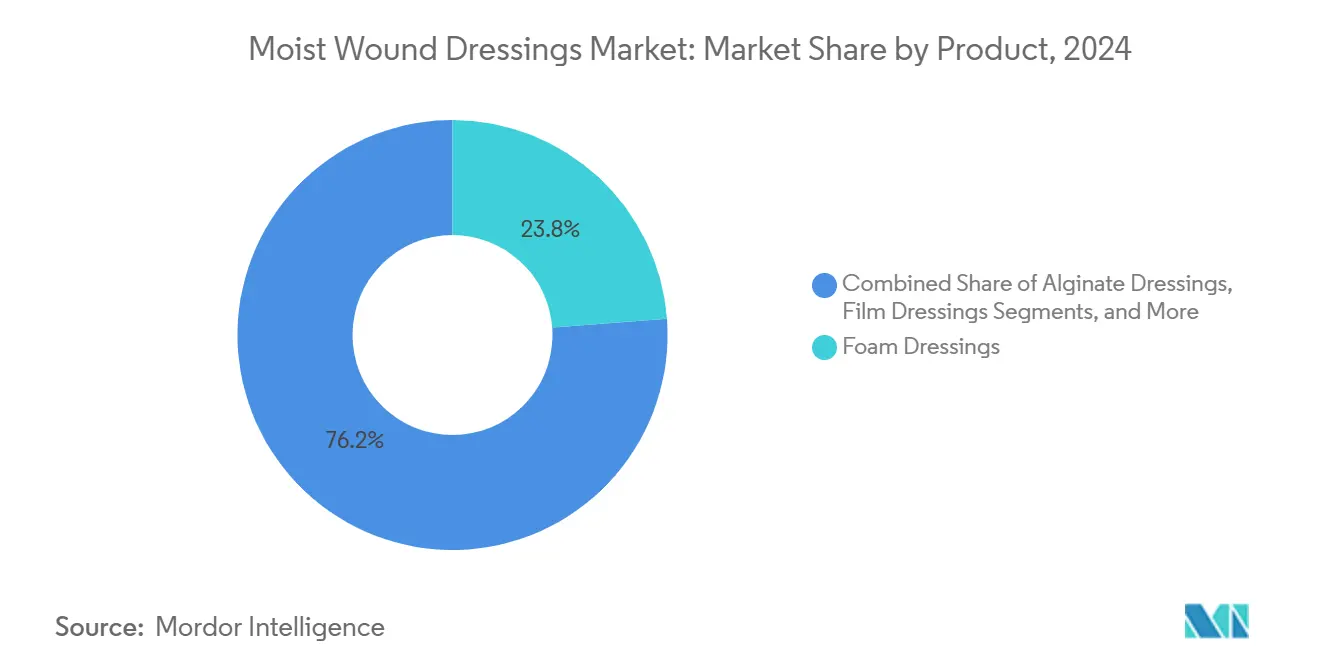
Note: Segment shares of all individual segments available upon report purchase
By Application: Surgical Dominance Yields to Diabetic Expansion
Post-operative and traumatic wounds generated 36.45% of 2024 revenue, evidencing surgeons’ near-universal preference for moisture-retentive coverings that lower seroma formation and minimize hypertrophic scarring. Protocol standardization—often embedded in enhanced recovery pathways—supports predictable order volumes from acute care hospitals. However, diabetic foot ulcers will see the briskest 6.35% CAGR through 2030, as population-level diabetes prevalence surpasses 10% in several G20 economies. Multidisciplinary foot clinics increasingly adopt hydrofiber-foam hybrids and oxygen-permeable hydrocolloids to curb amputation incidence, transforming a once episodic procurement pattern into steady demand.
Pressure ulcer prophylaxis represents another sizable slice, fueled by mandatory reporting of hospital-acquired pressure injuries and associated reimbursement penalties. Venous leg ulcer therapy, while smaller, receives momentum from guidelines calling for compression-compatible moist dressings that accelerate epithelial resurfacing. Burn units and plastic surgery departments continue exploring copper- and chitosan-laden variants that shorten donor-site healing by an estimated two days. These divergent application pathways ensure that no single dressing type meets all clinical scenarios, perpetuating innovation cycles and reinforcing competitive breadth within the moist wound dressings market.
By End User: Hospital Infrastructure Supports Homecare Transition
Hospitals captured 56.91% of the moist wound dressings market in 2024 owing to centralized purchasing, dedicated wound care teams, and immediate access to advanced therapies. In-patient settings remain the testing ground for smart dressings that link with electronic health records and deliver data on exudate pH or protease activity. Yet hospitals increasingly discharge stable patients earlier to lower costs, shifting responsibilities toward community nurses and family caregivers. CMS caregiver training reimbursement, coupled with proliferation of telehealth platforms, empowers non-specialists to maintain sophisticated dressing regimens at home.
Homecare is forecast to post a 6.57% CAGR, outpacing all other venues. Adoption hinges on simplified “peel-and-seal” formats, integrated change indicators, and video-assisted application guides. Long-term care facilities also show emerging appetite for moisture-retentive prophylactics that cut pressure ulcer incidence, aligning with regulatory quality metrics. Ambulatory wound clinics, often embedded in retail pharmacies, provide convenience for follow-up debridement and enable subscription-based dressing supply programs. Overall, end-user diversification diffuses purchasing power and compels manufacturers to tailor packaging, education tools, and supply-chain logistics to disparate care environments within the moist wound dressings market.
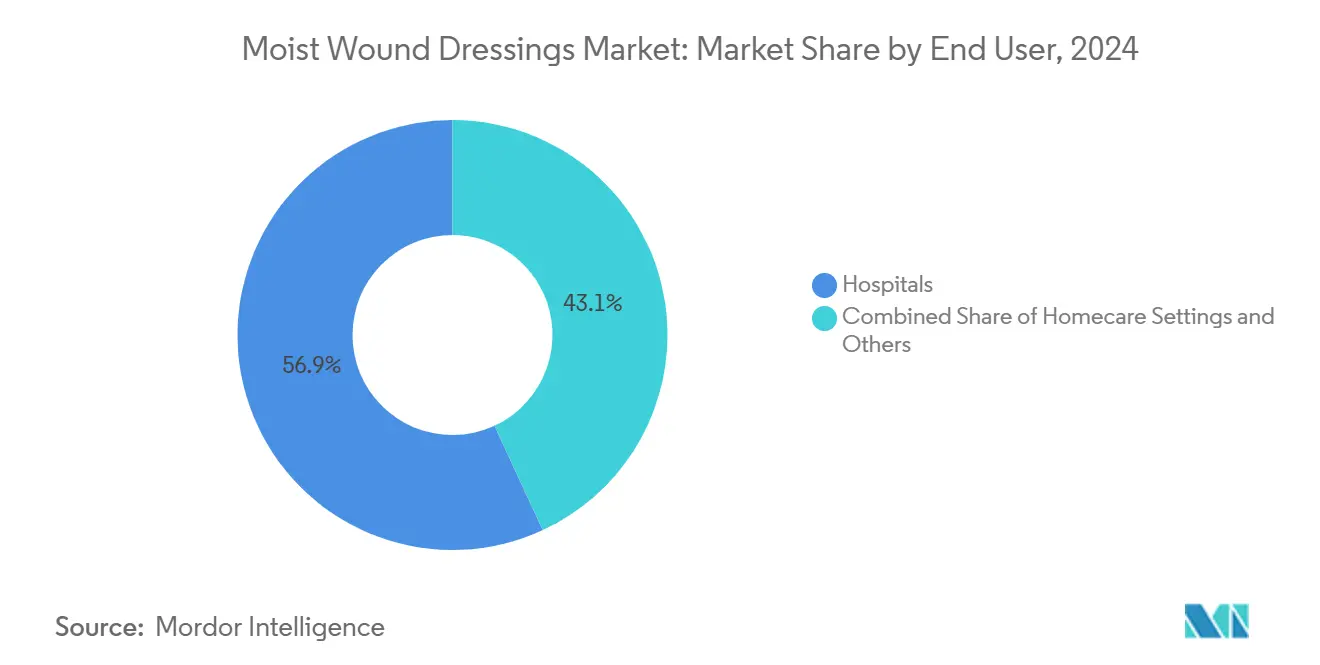
Note: Segment shares of all individual segments available upon report purchase
Geography Analysis
North America remains the epicenter of technological and reimbursement evolution. The region’s payer mix—Medicare, commercial insurers, and the Veterans Health Administration—collectively drives rapid diffusion of clinically proven products. Providers increasingly deploy remote monitoring kits that bundle foam dressings with smartphone-linked pH sensors, enabling same-day intervention when inflammation spikes. Cross-border supply chains are resilient due to the United States-Mexico-Canada Agreement, though manufacturers are localizing production to mitigate tariff and freight volatility.
Asia-Pacific’s trajectory reflects a convergence of epidemiology and policy. China’s Healthy China 2030 plan earmarks funds for chronic disease prevention, channeling investment into diabetic foot clinics where hydrofiber dressings cut debridement frequency. In India, state-level health insurance schemes reimburse advanced dressings for low-income patients undergoing limb-salvage surgery, stimulating public-sector tenders. Japanese and South Korean markets focus on pressure-injury prevention in super-aged populations, fostering adoption of silicone-foam prophylactics designed to remain intact during MRI scans.
Europe exhibits nuanced growth. Northern European health systems emphasize home-based care, prompting high uptake of antimicrobial foams with twelve-day wear protocols that minimize nurse visits. Southern Europe’s constrained public budgets favor cost-effectiveness studies; recent NHS England real-world data showed a 19% reduction in weekly dressing changes when switching from plain gauze to hydrocolloid, saving USD 1.7 million annually. East European accession to common procurement procedures brings price harmonization but also intensifies competition from Asia-Pacific suppliers, pressuring local incumbents to differentiate through sustainability certifications and recyclable packaging.
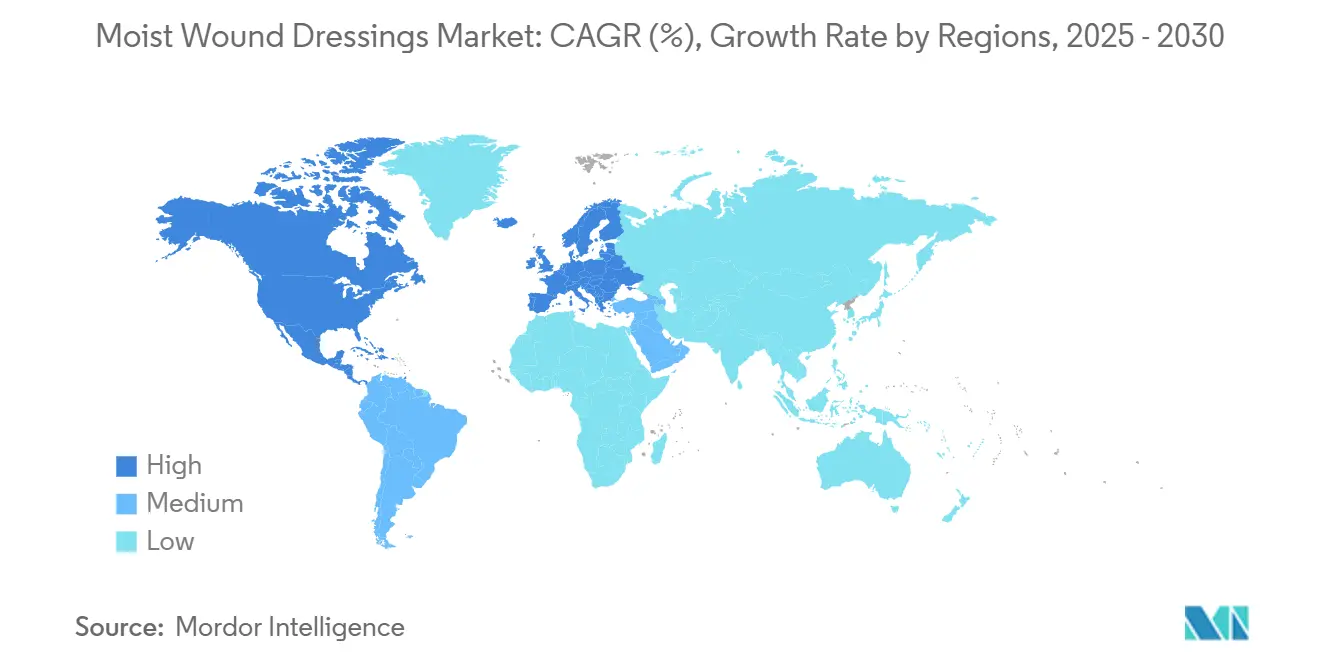
Competitive Landscape
The moist wound dressings market supports a mid-tier concentration profile characterized by diversified portfolios and region-specific strengths. Smith+Nephew, Mölnlycke, 3M (under spin-off Solventum), ConvaTec, and Coloplast collectively hold an estimated 60% of global revenue, leveraging proprietary foams, hydrofibers, and silicone adhesives. R&D pipelines emphasize multifunctionality; examples include Mölnlycke’s Mepilex Border Flex Plus, which integrates Flex Technology for conformability and Safetac silicone for atraumatic removal, and ConvaTec’s Aquacel Ag + Extra, combining ionic silver with Hydrofiber gelling.
Strategic moves frequently pair acquisition with technology cross-pollination. Coloplast’s 2024 purchase of Kerecis injected fish-skin xenograft know-how into its dressing portfolio, opening an entry into biologics. 3M’s Solventum division is piloting carbon-nanotube-embedded sensors that transmit exudate viscosity data to clinicians, aiming for FDA De Novo clearance in 2026. Meanwhile, regional players such as HARTMANN strengthen European presence through evidence-based marketing.
Start-ups and academic spin-offs intensify innovation pressure. U.S.-based Swift Medical offers a computer-vision platform that quantifies wound size and suggests dressing types, partnering with foam manufacturers for integrated care bundles. Singapore’s WoundMaestro develops enzymatic hydrogels that release antimicrobial peptides in response to pH shifts, targeting Southeast Asian diabetic populations. Collectively, these entrants prompt incumbents to accelerate digital integration, sustainability initiatives, and clinical validation, maintaining a dynamic competitive equilibrium in the moist wound dressings market.
Moist Wound Dressings Industry Leaders
Fleming Medical Ltd
Smith & Nephew plc
Essity AB
DermaRite Industries LLC
AMERX Health Care Corporation
- *Disclaimer: Major Players sorted in no particular order
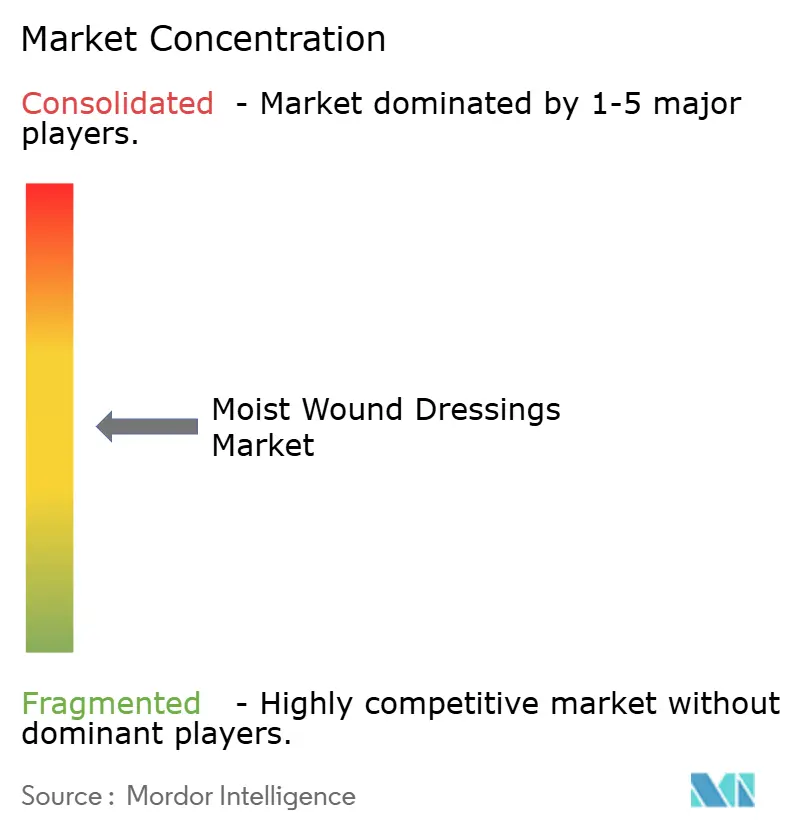


Recent Industry Developments
- June 2025: TekniPlex Healthcare opened a 200,000-square-foot sterile packaging plant in Madison, Wisconsin, featuring recyclable waste streams designed for advanced wound-care product lines.
- January 2025: Coloplast introduced Biatain Silicone Fit nationwide, a prophylactic foam approved to prevent pressure injury as well as manage exudating wounds.
- July 2023: Coloplast agreed to acquire Icelandic biologics firm Kerecis, expanding access to fish-skin graft technology for chronic wounds.
- June 2023: Evonik subsidiary JeNaCell launched epicite balance, a biosynthetic cellulose dressing distributed to European hospitals and community centers.
Research Methodology Framework and Report Scope
Market Definitions and Key Coverage
Our study defines the moist wound dressings market as single-use or limited-wear dressings that keep the wound bed humid to speed tissue repair and manage exudate. Products covered are foam, alginate, hydrocolloid, hydrogel, film, collagen, antimicrobial, silver, and contact-layer variants supplied sterile to hospitals, clinics, and home-care providers.
Scope Exclusions: Traditional dry gauze, negative-pressure wound therapy devices, and bioengineered skin substitutes lie outside this scope.
Segmentation Overview
- By Product
- Foam Dressings
- Alginate Dressings
- Hydrocolloid Dressings
- Hydrogel Dressings
- Film Dressings
- Collagen Dressings
- Antimicrobial/Silver Dressings
- Contact-Layer Dressings
- Others
- By Application
- Burn Wounds
- Pressure Ulcers
- Diabetic Foot Ulcers
- Surgical / Traumatic Wounds
- Venous Leg Ulcers
- Other Applications
- By End User
- Hospitals
- Homecare Settings
- Others
- By Geography
- North America
- United States
- Canada
- Mexico
- Europe
- Germany
- United Kingdom
- France
- Italy
- Spain
- Rest of Europe
- Asia-Pacific
- China
- Japan
- India
- Australia
- South Korea
- Rest of Asia-Pacific
- Middle East & Africa
- GCC
- South Africa
- Rest of Middle East & Africa
- South America
- Brazil
- Argentina
- Rest of South America
- North America
Detailed Research Methodology and Data Validation
Primary Research
Interviews with wound-care nurses, procurement heads, and regional distributors across North America, Europe, and Asia let us test exudate-level mix assumptions, price corridors, and guideline changes, ensuring missing variables are filled and findings are grounded.
Desk Research
We begin each update by mining open datasets such as WHO and OECD wound-linked hospitalization files, US CMS procedure volumes, EU Eudamed device listings, and tariff code 3005 trade statistics, anchoring baseline demand. Context is enriched with wound-care association yearbooks, peer-reviewed journals, and 10-K filings that reveal average selling prices and clinician uptake cues. Paid intelligence from D&B Hoovers, Dow Jones Factiva, and Volza then sharpens supplier revenue splits, cross-border trade swings, and pricing trends, giving us early signals on channel shifts before we move to validation. This list is illustrative only; many other sources support data collection, confirmation, and clarification.
Market-Sizing & Forecasting
We apply a top-down reconstruction that links inpatient and outpatient wound episodes, typical dressing consumption per case, and import-export balances, then cross-check totals with supplier revenue roll-ups and sampled hospital ASP × volume data. Key drivers include diabetic population trends, elective surgery recovery, foam-to-hydrocolloid mix shifts, and reimbursement code additions. Five-year forecasts use multivariate regression blended with scenario analysis, with elasticities vetted during expert calls. Gaps in bottom-up inputs are bridged through regional penetration benchmarks.
Data Validation & Update Cycle
Mordor analysts run multi-layer peer reviews, variance checks, and historic trend overlays. Any anomaly triggers fresh calls with experts. Models refresh each year, and material events such as silver-dressing recalls prompt interim revisions.
Why Mordor's Moist Wound Dressings Baseline Earns Decision-Maker Trust
Published estimates often diverge because firms slice the market differently, lock exchange rates, or project trends on outdated procedure counts.
Key gap drivers include bundling of bioengineered grafts with moist dressings, static average selling prices, and irregular refresh cadences, whereas Mordor revises variables every twelve months and discloses all assumptions.
Benchmark comparison
| Market Size | Anonymized source | Primary gap driver |
|---|---|---|
| USD 5.05 B (2025) | Mordor Intelligence | - |
| USD 4.47 B (2023) | Regional Consultancy A | Older base year and omission of Asia-Pacific home-care channel |
| USD 5.20 B (2024) | Global Consultancy A | Bundles antimicrobial foams and uses static ASPs |
| USD 5.15 B (2024) | Industry Journal B | Relies on vendor press releases and straight-line CAGR without diabetic incidence inputs |
These comparisons show that scope choice and refresh timing can swing estimates by half a billion dollars. Mordor's disciplined variable selection, annual expert touchpoints, and transparent audit trail provide a balanced, repeatable baseline that decision-makers can trust.


Key Questions Answered in the Report
How big is the Moist Wound Dressings Market?
The Moist Wound Dressings Market size is expected to reach USD 5.05 billion in 2025 and grow at a CAGR of 5.30% to reach USD 6.54 billion by 2030.
Why are diabetic foot ulcers a high-growth application?
Rising diabetes prevalence and guideline-driven focus on limb preservation propel diabetic foot ulcer dressings at a 6.35% CAGR.
Who are the key players in Moist Wound Dressings Market?
Fleming Medical Ltd, Smith & Nephew plc, Essity AB, DermaRite Industries LLC and AMERX Health Care Corporation are the major companies operating in the Moist Wound Dressings Market.
Which is the fastest growing region in Moist Wound Dressings Market?
Asia-Pacific leads regional growth at 6.89% CAGR, driven by expanding healthcare infrastructure and increasing chronic wound incidence.
Which region has the biggest share in Moist Wound Dressings Market?
In 2025, the North America accounts for the largest market share in Moist Wound Dressings Market.
Which product category leads the market?
Foam dressings hold the leading 23.87% share, favored for versatility and high absorption.
Page last updated on:
